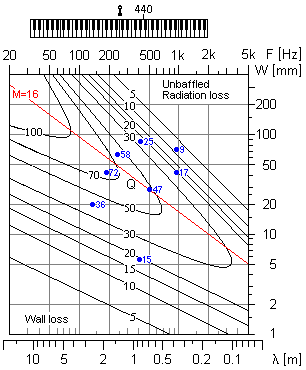Can there be such a thing as an optimal bore size for a whistle, relative to its key? Tastes for certain tonal characteristics vary, some prefer narrower, some wider whistles for various situations.
I used to think that wide and narrow bore can be expressed by the length to bore ratio, but not any more. Now for me "wide" and "narrow" is just relative to what I use as "standard". Obviously that is subjective, and also depends on suitable tubing I found.
But underneath is a more fundamental problem about scaling into different keys. To build whistles with similar tonal characteristic in different keys larger whistles in lower keys need to be a bit narrower than simple proportional scaling would suggest. In other word: the length/bore ratio is becoming larger with larger whistles.
This is well known to organ builders. Some have used a scaling method called "Normalmensur" for hundreds of years, in which the 17th pipe in a chromatic scale has half the width of the first pipe (called 16th halving ratio) (see for instance http://en.wikipedia.org/wiki/Organ_flue_pipe_scaling).
I studied this a bit and found that from my experience experimenting with a variety of tubing for various whistle keys the 16th halving ratio was a lot better than a 12th halving ratio (octave pipe has half the width), but not quite optimal. I think a 15th halving ratio is better. I draw consolation from the fact that many organ builders did not adhere to a 16th halving scheme, and many organs are build with narrower ratios.
Further, if you have a look at this paper about the Q value of a pipe resonator by Johan Liljencrants (warning: this goes into physics): A Q value is an expression of the "quality" of an oscillation, and basically the reverse of the sum of the losses occurring in an oscillation. The basic losses in an acoustic pipe resonator are wall loss and radiation loss. There is a nice graph at Fig 3 illustrating the estimated Q value (calculated as a combination of the estimated losses) in relationship to frequency and pipe width (of square pipes), which I will show here.

The black curved lines combine points of equal Q, like isobars on a weather chart. Values decrease towards the upper left corner due to growing radiation losses (power losses resulting from the open ends of the pipe), which grow with growing frequencies and wider pipes. Values decrease towards the lower left corner due to growing wall losses (power losses resulting from friction at the boundary at the pipe walls), which grow with lower frequencies and narrower pipes. From top left to bottom right we could trace a line which combines the highest possible Q values for each frequency, thereby relating each frequency to an optimal pipe width. It would be optimal inasmuch as it implies the least amount of losses, which results in a pipe (or whistle) which is optimally powered.
I thought that very interesting. The red line marked M=16 corresponds to a pipe scaling halving the width every 16th semitone (the classical Normalmensur of organ builders). You can see it is not quite near the line of highest Q. Such a line would need to be a little bit lower and of different angle, meaning a different ratio. I found that a line corresponding to a halving of width every 15 semitones (M=15) would meet that much better and is very near a line of highest Q.The slope of the red line in fig 3 shows how width varies with frequency in a pipe rank with halving number M=16. The vertical position of this line is put similar to the Töpfer Normalmensur with W =137 mm at 8'C (65 Hz), same area as for diameter 155 mm. One may speculate whether pipe makers of the past have lead the evolution of pipe scaling toward maximum Q.
Looking at the actual width values in relation to frequencies using such a high Q line, I get ca 20mm pipe width for C5. But my "standard" C whistle uses a 14mm bore. But then whistles are not organ pipes, and operate over two octaves. So the lowest note is not the optimum (acoustically), the optimum is found up the whistle scale, around the fourth or fifth note. For these notes the actual pipe length is a lot shorter. So taking two thirds of the width values on Fig 3 we get some meaningful values for optimal whistle width in relation to frequencies.
Some maths: for whistle width scaling a 15th halving ratio is pretty close to optimal. For each half tone step that means a ratio of 15th root of 2, or ~1.04729, or a ratio between octaves of ~1.7411. The graph suggests an optimal ratio of about 1.77 between octaves, translating to a half tone step ratio of 1.04873. The difference is not very big, and both would give good results for practical width scaling.
A practical example:
I take a high C whistle with 14mm bore as optimal, length/bore=21.3.
Using an octave ratio of 1.77 I calculate for a low G whistle the optimal bore to 17.8mm. In practise I use 18mm bore with very good result, length/bore=22.4.
A 20mm bore gives me a good wide bore low G whistle, length/bore=20.
Note the rise in length/bore from 21.3 to 22.4, even though both whistles are similar in their tonal character.
Clearly the length to bore ratio of a particular whistle does not express if this whistle is wide or narrow in bore. We need to take account of the key a well. Lower whistles are relatively narrower, and progressively narrower the lower they are, to exhibit similar tonal character.